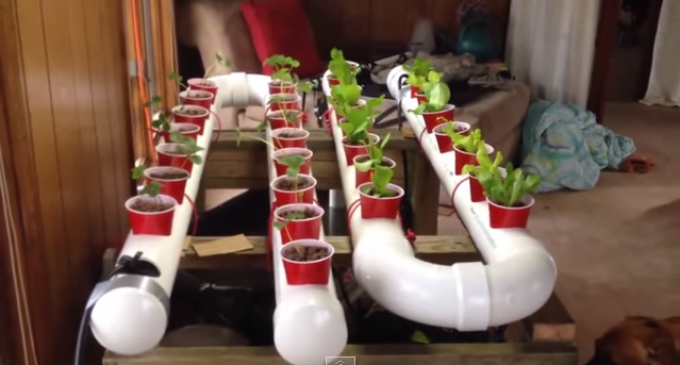
For around $130 and 3 hours of your time, you can build a portable aquaponic system in your home or apartment that will produce organic plants and fish.
This is probably the easiest system for producing organic food you can make. There’s very little maintenance as the system is a miniature, self-contained ecosystem.
Aquaponics is a combination of aquaculture (raising fish and other aquatic animals) with hydroponics (the cultivation of plants in water instead of soil). It is a system for farming plants and fish together in a mutually beneficial cycle. The fish produce waste which turns into nitrates and ammonia that the plants feed on, keeping the water clean for the fish.
An indoor, desktop system:
1) Feed Your Fish (Daily)
Your fish are an essential part of your aquaponics system, so it’s important that they stayfully nourished. You should feed them twice a day (or at least once), once in the morning and again before sun down.
You can use an automatic fish feeder to help you do this if you’re unavailable, but being present while feeding your fish also serves as a health check, because if you see that your fish are not eating actively, then it may be a sign that something is wrong.
2) Check The Temperature Of Your Fish Tank (Daily)
It’s essential that you have the correct water temperature in your fish tank to make it the ideal environment for the aquaponic fish species that you have.
It’s a quick check that can easily be done just by searching on the ideal temperature for the type of fish you’ll be raising.
3) Check For Insects (Weekly)
You want to take care of an insect problem sooner rather than later, because it can quickly get out of control. Any time you harvest a plant, you should check for insects, which will usually reside underneath plant leaves or in the steam sections.
4) Check The pH Levels (Weekly)
The pH level is your aquaponics system determines the ability of your plants nutrient intake, the bacteria’s reproduction abilities and the health of your fish. It’s safe to say that pH is arguably the most important factor of how well your aquaponics system runs, so it needs to be checked at least once a week.
The ideal pH level is between 6.8-7.0, and while some aquaponic systems steadily maintain this, over time, most systems pH will decrease naturally. If it falls below 6.5, it’s time to add hydrated lime or potash to increase the pH levels again.
5) Check The Ammonia Levels (Weekly)
Like pH, another important indicator of the overall health of your aquaponics system is the ammonia levels. This also needs to be checked once a week so you can spot any problems that may turn out to be disastrous.
Ammonia levels should be equal to or less than 0.5ppm. A sudden rise in this means that you may have a dead fish somewhere within your tank.
6) Check The Nitrate Levels (Monthly)
Nitrates are usually a good thing, but when they rise to unnatural levels (above 150ppm), this could mean that there are not enough plants to take in the nitrogen that’s being released by the nitrifying bacteria.
You can solve this three ways – Add more plants, harvest some fish or add another grow bed to your aquaponics system.
7) Check The Pumps & Plumbing System (Monthly)
Check all the pumps and plumbing is connected and working properly for successful circulation. This should really be checked everyday, while cleaning out all the pumps and pipes should be done once a month.
It’s a hassle and dirty job but it has to be done in order to maintain the efficiency of your system. A good way to clean them is to run high-pressure water from a hose through each component.


I have one in my home and it’s fun and keeps fresh food around that never gets to the table… My kids eat them before there is a chance
The fish can be in a completely different container off to the side… One pump from the fish tank overflow to the top… Use gravity from there…
Also look up aquaponics on YouTube
There are a lot of do-it-yourself videos that you can pick and choose from watch about 10-15 of them and then make your system that’s what I did
“veggies” 🙂
Also look up
Ram pumps
Hydroelectric generators
There is a way to generate electricity for the lighting that you need
as well as the water where you need it without using electricity
Wow
Gotta do that
https://www.facebook.com/Permacube-Revolution-Inc-962593310461543/
Hi Amazing people,
Believe that you can grow your own food organically in your own backyard.JOIN US! in our mission to help feed the world. Our Product is called PermaCube and it is an Organic food growing Processing and Storage Facility which uses Permaculture techniques to maximize yield in a small space.
Please like our Page and Share to your friends and family.
Look out for our Website. This will be available soon.
Thank you,
So many reviews for you to choose the suitable fish food at https://itday.com/fish/five-best-tropical-fish-pet-beginners-fish-food-guide/
Sheryle Bolden
That rocks